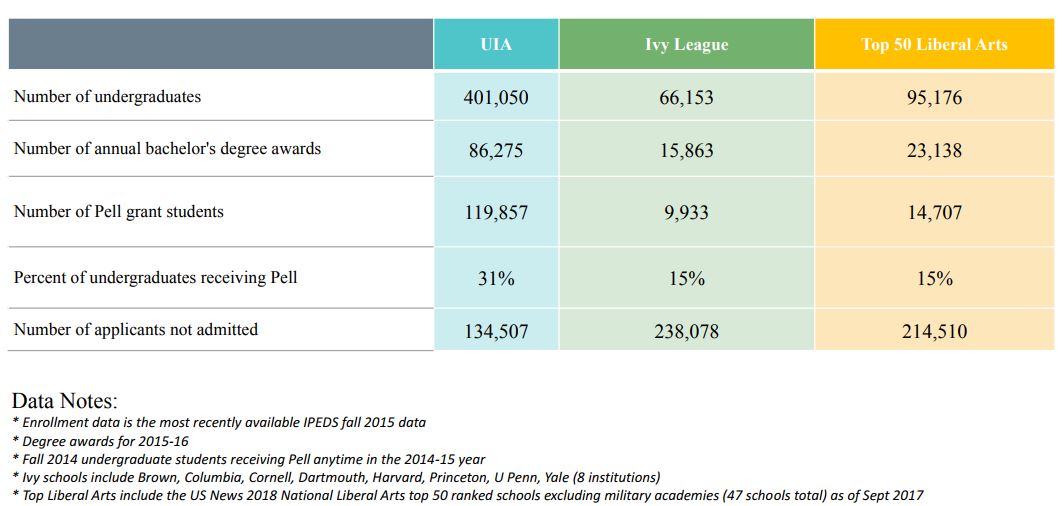You have /5 articles left.
Sign up for a free account or log in.
Three years ago a group of public research universities set out to prove that by working together they could significantly increase the completion rates of low-income students without reducing quality or diminishing their research productivity.
And last week they released new evidence that they are not only achieving their goals, but on track to surpass them.
The 11 universities make up the University Innovation Alliance, which released new data Thursday showing that they have increased the number of low-income graduates at their institutions by 24.7 percent in the past three years. The increase also puts the alliance on pace to surpass its total graduation goals.
"These 11 presidents and chancellors united around a sense of urgency and a shared problem, and they've held each other accountable with data-sharing agreements and transparency," said Bridget Burns, executive director of the UIA. "The alliance is about helping those campuses share what is working, adopt new interventions and scale up what's working faster."
Members of the UIA
Arizona State University
Georgia State University
Iowa State University
Michigan State University
Ohio State University
Oregon State University
Purdue University
University of California, Riverside
University of Central Florida
University of Kansas
University of Texas at Austin
When the alliance began three years ago, the goal was to graduate an additional 68,000 undergraduates by 2025 and have at least half of those students come from low-income families. The total number of undergraduate degrees awarded by the members has increased by 9.2 percent since 2014 -- from 79,170 to 86,436. The alliance is expected to exceed public attainment goals, with an additional 94,000 graduates by 2025.
The universities haven't given up their research missions, but the focus is now on social mobility, said Kim Wilcox, chancellor of UC Riverside.
"We focused on simple things," Wilcox said. "We focused on the number of credits students take."
Completion became the overall improvement goal, so the administration and faculty members encouraged students to take a minimum 15 credits per term, he said.
Riverside is also socioeconomically diverse, with about 60 percent of students on campus receiving Pell Grants.
"If you raise the overall graduation rate, you raise the rate of Pell students," Wilcox said.
Wilcox placed an emphasis on building not only a relationship with the other presidents and chancellors but asking that his senior aides do the same with their counterparts at the other campuses. The point was to share data, and even if Riverside didn't replicate the exact model Georgia State used, they would at least understand the common principles behind achieving success, he said.
Despite some criticism surrounding the completion agenda and encouraging students to graduate on time, Wilcox said, it's important for students to realize that staying in college longer is more expensive for them.
"We have to help them understand it's another year in the job market they're squandering," he said.
Burns said the university presidents understood that the degree-attainment challenge isn't just about increasing the number of graduates but increasing degree production across the socioeconomic spectrum.
At Ohio State, the university focused on data analytics and advising and examined the work UIA did with helping guide students to the right career path, said Michael Drake, the university's president. Ohio State, like many of the others in the alliance, also focused on emergency aid. Last month the group started a new initiative to provide completion grants to students facing financial pressures in their last semester of study.
"There are people who believe affordability, access and excellence are separate things," Drake said. "I believe they all modify each other positively -- if we're doing our best work as a public research university, we're maximizing affordability, access and excellence at the same time. We're a Research I and that's critically important to us, but that's not incompatible with social mobility."
But there are still challenges facing the institutions despite the improvement in graduation numbers. Drake said they're still encountering a diverse group of students who come to the university with an uneven level of preparation from high school.
In a comparative study, the 11 alliance members learned that 31 percent of their undergraduate students receive Pell Grants compared to 15 percent of undergraduates at Ivy League institutions and at 50 other selective liberal arts colleges.
"Despite all of the attention around elite institutions talking about social mobility and economics, the entire Ivy League doesn't serve 10,000 low-income students," Burns said. "Where we focus our attention matters, and these presidents are doing something that is bucking a trend. They're resisting pressure from other sources … it isn't incentivized or encouraged, and you won't see rankings for this effort."









